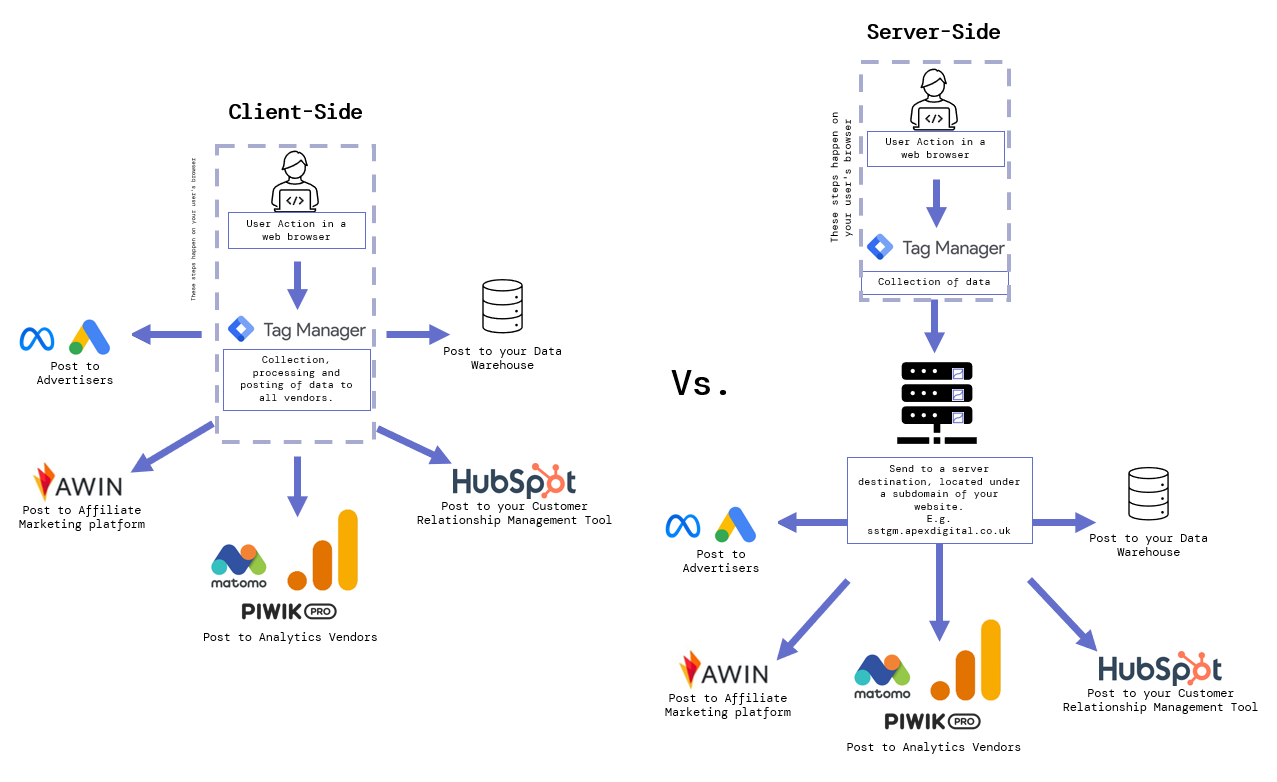Server Side tagging
Fully Control Your Data flows..
Migrate your data to the cloud with Server Side Tagging and gain benefits you might not have realised were possible.
What is Server Side Tagging?
Instead of sending your data directly to Google Analytics from the user’s web browser, you send the data to your own server for processing and onward destinations.
How Server Side Tagging Works:

What’s the purpose?
By sending data once to your server location under your domain name, it is now yours to do what you want with.. It is first party data.
Benefits of Server Side Tagging
- First party data allows you more control. E.g. If you own a car, you can modify it any way you wish and keep it for as long as you like. If you rent a car, you cannot change it. A similar principle applies to your data.
- Server Side Tagging will speed up your website. Instead of processing each request to each vendor separately from within the browser, you burden the browser with a fraction of the workload because all the processing happens on your server.
- Become more trusted with your customers’ data. Privacy is a hot topic in the general public. Become a more responsible partner by keeping data owned and in-house, without risking Personal Identifiable Information leaks to 3rd parties.
- Improve the quality of your digital data. Stop the cookie rot on many browsers that limit cookie lifetimes to 7 days, causing you to lose visibility on marketing campaign effectiveness. Browsers can tell when the data is being sent directly to Google Analytics, but first party data transmission with Server Side Tagging is seen as privacy safe.
- In a similar way, if the end user employs ad blockers or a privacy safe VPN, your own domain is not classed as malicious, so is therefore not blocked.
Would your business benefit?
There are many benefits to Server Side GTM, but beware, it is not a free solution. Expect to pay at least $100 a month in server utilisation and processing costs. You would also need a specialist to set it up and manage the implementation, which are costs to factor in.
There are risks if things do not go right, if suddenly a huge increase in traffic spikes CPU utilisation, or lots of processing begins to occur for complex data flows, this could increase costs. Luckily, there are alerts you can set up in Google Cloud to cap spending.
The decision comes down to the cost vs benefit realisation. If you are a small business, the added complexity and spend may not be required if you deem the data served by 3rd party vendors to be adequate. However, If this investment would be only a small proportion of your marketing budget (which would be most medium to large businesses), the decision to go server-side clearly has benefits outweighing the costs.
Would Server-Side Tagging help your marketing and data governance processes?
Contact us for an introduction call today to discuss if your business is suitable to transition to Server Side Tagging
Get in touch
Or book a call directly
Read more…
-
10 things to analyse that will improve website performance
What are the most effective data points to track that tell you how well your website is functioning? The purpose of most websites is either to drive ecommerce sales, drive leads or drive engagement with content. Some of these are applicable to all of these, while some are quite specific. The key metric we should…
-
Privacy Sandbox: What is happening to 3rd party cookies?
You may have seen some noise online about the phasing out of third-party cookies and the introduction of Google’s Privacy Sandbox. This post is to explain what this means in varying aspects of digital marketing. There’s lots of emotive & negative language to describe this change. Some may call it a “cookie-pocalypse”, be very wary…
-
Alternatives to GA4 (Part 1): Where is Digital Analytics Heading?
What other Digital Analytics tools are available? There are many Digital Analytics Tools that are alternatives to Google Analytics 4 (GA4) on the market today. These existed before GA4, but have come to the forefront because of the consensus that standard GA4 can be limited for many basic use cases. In this article I’m going…